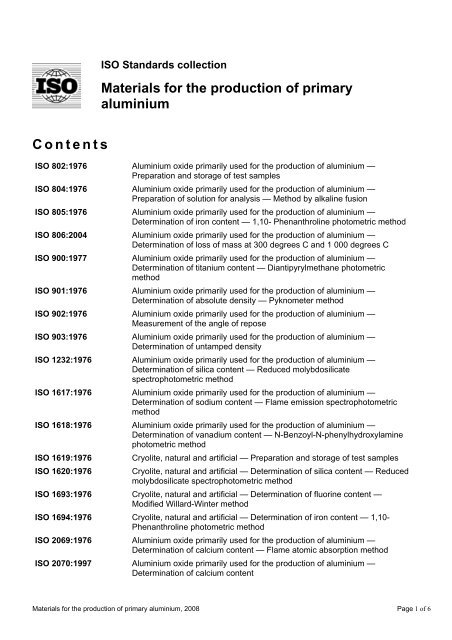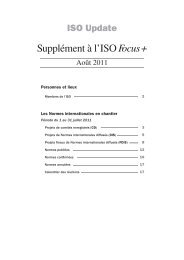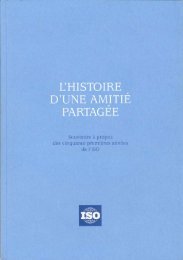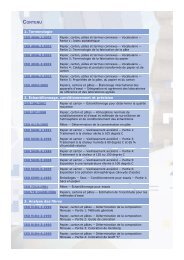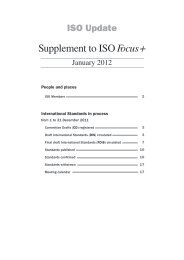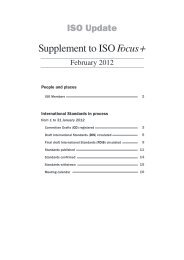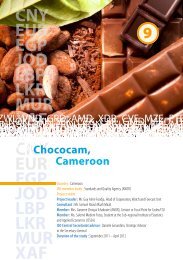Aluminium CD-ROM - ISO
Aluminium CD-ROM - ISO
Aluminium CD-ROM - ISO
You also want an ePaper? Increase the reach of your titles
YUMPU automatically turns print PDFs into web optimized ePapers that Google loves.
Contents<br />
<strong>ISO</strong> Standards collection<br />
Materials for the production of primary<br />
aluminium<br />
<strong>ISO</strong> 802:1976 <strong>Aluminium</strong> oxide primarily used for the production of aluminium —<br />
Preparation and storage of test samples<br />
<strong>ISO</strong> 804:1976 <strong>Aluminium</strong> oxide primarily used for the production of aluminium —<br />
Preparation of solution for analysis — Method by alkaline fusion<br />
<strong>ISO</strong> 805:1976 <strong>Aluminium</strong> oxide primarily used for the production of aluminium —<br />
Determination of iron content — 1,10- Phenanthroline photometric method<br />
<strong>ISO</strong> 806:2004 <strong>Aluminium</strong> oxide primarily used for the production of aluminium —<br />
Determination of loss of mass at 300 degrees C and 1 000 degrees C<br />
<strong>ISO</strong> 900:1977 <strong>Aluminium</strong> oxide primarily used for the production of aluminium —<br />
Determination of titanium content — Diantipyrylmethane photometric<br />
method<br />
<strong>ISO</strong> 901:1976 <strong>Aluminium</strong> oxide primarily used for the production of aluminium —<br />
Determination of absolute density — Pyknometer method<br />
<strong>ISO</strong> 902:1976 <strong>Aluminium</strong> oxide primarily used for the production of aluminium —<br />
Measurement of the angle of repose<br />
<strong>ISO</strong> 903:1976 <strong>Aluminium</strong> oxide primarily used for the production of aluminium —<br />
Determination of untamped density<br />
<strong>ISO</strong> 1232:1976 <strong>Aluminium</strong> oxide primarily used for the production of aluminium —<br />
Determination of silica content — Reduced molybdosilicate<br />
spectrophotometric method<br />
<strong>ISO</strong> 1617:1976 <strong>Aluminium</strong> oxide primarily used for the production of aluminium —<br />
Determination of sodium content — Flame emission spectrophotometric<br />
method<br />
<strong>ISO</strong> 1618:1976 <strong>Aluminium</strong> oxide primarily used for the production of aluminium —<br />
Determination of vanadium content — N-Benzoyl-N-phenylhydroxylamine<br />
photometric method<br />
<strong>ISO</strong> 1619:1976 Cryolite, natural and artificial — Preparation and storage of test samples<br />
<strong>ISO</strong> 1620:1976 Cryolite, natural and artificial — Determination of silica content — Reduced<br />
molybdosilicate spectrophotometric method<br />
<strong>ISO</strong> 1693:1976 Cryolite, natural and artificial — Determination of fluorine content —<br />
Modified Willard-Winter method<br />
<strong>ISO</strong> 1694:1976 Cryolite, natural and artificial — Determination of iron content — 1,10-<br />
Phenanthroline photometric method<br />
<strong>ISO</strong> 2069:1976 <strong>Aluminium</strong> oxide primarily used for the production of aluminium —<br />
Determination of calcium content — Flame atomic absorption method<br />
<strong>ISO</strong> 2070:1997 <strong>Aluminium</strong> oxide primarily used for the production of aluminium —<br />
Determination of calcium content<br />
Materials for the production of primary aluminium, 2008 Page 1 of 6
<strong>ISO</strong> 2071:1976 <strong>Aluminium</strong> oxide primarily used for the production of aluminium —<br />
Determination of zinc content — Flame atomic absorption method<br />
<strong>ISO</strong> 2072:1981 <strong>Aluminium</strong> oxide primarily used for the production of aluminium —<br />
Determination of zinc content — PAN photometric method<br />
<strong>ISO</strong> 2073:1976 <strong>Aluminium</strong> oxide primarily used for the production of aluminium —<br />
Preparation of solution for analysis — Method by hydrochloric acid attack<br />
under pressure<br />
<strong>ISO</strong> 2366:1974 Cryolite, natural and artificial — Determination of sodium content — Flame<br />
emission and atomic absorption spectrophotometric methods<br />
<strong>ISO</strong> 2367:1972 Cryolite (natural and artificial) — Determination of aluminium content — 8-<br />
Hydroxyquinoline gravimetric method<br />
<strong>ISO</strong> 2828:1973 <strong>Aluminium</strong> oxide primarily used for the production of aluminium —<br />
Determination of fluorine content — Alizarin complexone and lanthanum<br />
chloride spectrophotometric method<br />
<strong>ISO</strong> 2829:1973 <strong>Aluminium</strong> oxide primarily used for the production of aluminium —<br />
Determination of phosphorus content — Reduced phosphomolybdate<br />
spectrophotometric method<br />
<strong>ISO</strong> 2830:1973 Cryolite, natural and artificial — Determination of aluminium content —<br />
Atomic absorption method<br />
<strong>ISO</strong> 2865:1973 <strong>Aluminium</strong> oxide primarily used for the production of aluminium —<br />
Determination of boron content — Curcumin spectrophotometric method<br />
<strong>ISO</strong> 2865:1973 / Cor. Technical Corrigendum 1 to <strong>ISO</strong> 2865:1973<br />
1:1991<br />
<strong>ISO</strong> 2926:2005 <strong>Aluminium</strong> oxide used for the production of primary aluminium — Particle<br />
size analysis for the range 45 m to 150 m — Method using electroformed<br />
sieves<br />
<strong>ISO</strong> 2927:1973 <strong>Aluminium</strong> oxide primarily used for the production of aluminium —<br />
Sampling<br />
<strong>ISO</strong> 2961:1974 <strong>Aluminium</strong> oxide primarily used for the production of aluminium —<br />
Determination of an adsorption index<br />
<strong>ISO</strong> 3390:1976 <strong>Aluminium</strong> oxide primarily used for the production of aluminium —<br />
Determination of manganese content — Flame atomic absorption method<br />
<strong>ISO</strong> 3391:1976 Cryolite, natural and artificial — Determination of calcium content — Flame<br />
atomic absorption method<br />
<strong>ISO</strong> 3393:1976 Cryolite, natural and artificial, and aluminium fluoride for industrial use —<br />
Determination of moisture content — Gravimetric method<br />
<strong>ISO</strong> 3429:1976 Sodium fluoride primarily used for the production of aluminium —<br />
Determination of iron content — 1,10- Phenanthroline photometric method<br />
<strong>ISO</strong> 3430:1976 Sodium fluoride primarily used for the production of aluminium —<br />
Determination of silica content — Reduced molybdosilicate<br />
spectrophotometric method<br />
<strong>ISO</strong> 3431:1976 Sodium fluoride primarily used for the production of aluminium —<br />
Determination of soluble sulphates content — Turbidimetric method<br />
<strong>ISO</strong> 3566:1976 Sodium fluoride primarily used for the production of aluminium —<br />
Determination of chlorides content — Turbidimetric method<br />
<strong>ISO</strong> 3699:1976 Anhydrous hydrogen fluoride for industrial use — Determination of water<br />
content — Karl Fischer method<br />
Materials for the production of primary aluminium, 2008 Page 2 of 6
<strong>ISO</strong> 4280:1977 Cryolite, natural and artificial, and aluminium fluoride for industrial use —<br />
Determination of sulphate content — Barium sulphate gravimetric method<br />
<strong>ISO</strong> 5930:1979 Cryolite, natural and artificial, and aluminium fluoride for industrial use —<br />
Determination of phosphorus content — Reduced molybdophosphate<br />
photometric method<br />
<strong>ISO</strong> 5931:2000 Carbonaceous materials used in the production of aluminium — Calcined<br />
coke and calcined carbon products — Determination of total sulfur by the<br />
Eschka method<br />
<strong>ISO</strong> 5938:1979 Cryolite, natural and artificial, and aluminium fluoride for industrial use —<br />
Determination of sulphur content — X-ray fluorescence spectrometric<br />
method<br />
<strong>ISO</strong> 5939:1980 Carbonaceous materials for the production of aluminium — Pitch for<br />
electrodes — Determination of water content — Azeotropic distillation<br />
(Dean and Stark) method<br />
<strong>ISO</strong> 5940:1981 Carbonaceous materials for the production of aluminium — Pitch for<br />
electrodes — Determination of softening point by the ring-and-ball method<br />
<strong>ISO</strong> 5940-2:2007 Carbonaceous materials used in the production of aluminium — Pitch for<br />
electrodes — Part 2: Determination of the softening point (Mettler softening<br />
point method)<br />
<strong>ISO</strong> 6257:2002 Carbonaceous materials used in the production of aluminium — Pitch for<br />
electrodes — Sampling<br />
<strong>ISO</strong> 6374:1981 Cryolite, natural and artificial, and aluminium fluoride for industrial use —<br />
Determination of phosphorus content — Atomic absorption spectrometric<br />
method after extraction<br />
<strong>ISO</strong> 6375:1980 Carbonaceous materials for the production of aluminium — Coke for<br />
electrodes — Sampling<br />
<strong>ISO</strong> 6376:1980 Carbonaceous materials for the production of aluminium — Pitch for<br />
electrodes — Determination of content of toluene-insoluble material<br />
<strong>ISO</strong> 6791:1981 Carbonaceous materials for the production of aluminium — Pitch for<br />
electrodes — Determination of contents of quinoline-insoluble material<br />
<strong>ISO</strong> 6997:1985 Carbonaceous materials for the production of aluminium — Calcined coke<br />
— Determination of apparent oil content — Heating method<br />
<strong>ISO</strong> 6998:1997 Carbonaceous materials for the production of aluminium — Pitch for<br />
electrodes — Determination of coking value<br />
<strong>ISO</strong> 6998:1997 / Cor. Technical Corrigendum 1 to <strong>ISO</strong> 6998:1997<br />
1:1999<br />
<strong>ISO</strong> 6999:1983 Carbonaceous materials for the production of aluminium — Pitch for<br />
electrodes — Determination of density — Pycnometric method<br />
<strong>ISO</strong> 8003:1985 Carbonaceous materials used in the production of aluminium — Pitch for<br />
electrodes — Measurement of dynamic viscosity<br />
<strong>ISO</strong> 8004:1985 Carbonaceous materials for the production of aluminium — Calcined coke<br />
and calcined carbon products — Determination of the density in xylene —<br />
Pyknometric method<br />
<strong>ISO</strong> 8005:2005 Carbonaceous materials used in the production of aluminium — Green and<br />
calcined coke — Determination of ash content<br />
<strong>ISO</strong> 8006:1985 Carbonaceous materials used in the production of aluminium — Pitch for<br />
electrodes — Determination of ash<br />
Materials for the production of primary aluminium, 2008 Page 3 of 6
<strong>ISO</strong> 8007-1:1999 Carbonaceous materials used in the production of aluminium — Sampling<br />
plans and sampling from individual units — Part 1: Cathode blocks<br />
<strong>ISO</strong> 8007-2:1999 Carbonaceous materials used in the production of aluminium — Sampling<br />
plans and sampling from individual units — Part 2: Prebaked anodes<br />
<strong>ISO</strong> 8007-3:2003 Carbonaceous materials used in the production of aluminium — Sampling<br />
plans and sampling from individual units — Part 3: Sidewall blocks<br />
<strong>ISO</strong> 8008:2005 <strong>Aluminium</strong> oxide primarily used for the production of aluminium —<br />
Determination of specific surface area by nitrogen adsorption<br />
<strong>ISO</strong> 8220:1986 <strong>Aluminium</strong> oxide primarily used for the production of aluminium —<br />
Determination of the fine particle size distribution (less than 60 mu/m) —<br />
Method using electroformed sieves<br />
<strong>ISO</strong> 8658:1997 Carbonaceous materials for use in the production of aluminium — Green<br />
and calcined coke — Determination of trace elements by flame atomic<br />
absorption spectrometry<br />
<strong>ISO</strong> 8723:1986 Carbonaceous materials for the production of aluminium — Calcined coke<br />
— Determination of oil content — Method by solvent extraction<br />
<strong>ISO</strong> 9055:1988 Carbonaceous materials for the production of aluminium — Pitch for<br />
electrodes — Determination of sulfur content by the bomb method<br />
<strong>ISO</strong> 9088:1997 Carbonaceous materials used for the production of aluminium — Cathode<br />
blocks and prebaked anodes — Determination of the density in xylene by a<br />
pyknometric method<br />
<strong>ISO</strong> 9406:1995 Carbonaceous materials for the production of aluminium — Green coke —<br />
Determination of volatile matter content by gravimetric analysis<br />
<strong>ISO</strong> 10142:1996 Carbonaceous materials for use in the production of aluminium — Calcined<br />
coke — Determination of grain stability using a laboratory vibration mill<br />
<strong>ISO</strong> 10143:1995 Carbonaceous materials for the production of aluminium — Calcined coke<br />
for electrodes — Determination of the electrical resistivity of granules<br />
<strong>ISO</strong> 10236:1995 Carbonaceous materials for the production of aluminium — Green coke<br />
and calcined coke for electrodes — Determination of bulk density (tapped)<br />
<strong>ISO</strong> 10237:1997 Carbonaceous materials for use in the production of aluminium — Calcined<br />
coke — Determination of residual-hydrogen content<br />
<strong>ISO</strong> 10238:1999 Carbonaceous materials used in the production of aluminium — Pitch for<br />
electrodes — Determination of sulfur content by an instrumental method<br />
<strong>ISO</strong> 11412:1998 Carbonaceous materials for the production of aluminium — Calcined coke<br />
— Determination of water content<br />
<strong>ISO</strong> 11713:2000 Carbonaceous materials used in the production of aluminium — Cathode<br />
blocks and baked anodes — Determination of electrical resistivity at<br />
ambient temperature<br />
<strong>ISO</strong> 12977:1999 Carbonaceous materials for use in the production of aluminium — Pitch for<br />
electrodes — Determination of volatile matter content<br />
<strong>ISO</strong> 12979:1999 Carbonaceous materials for use in the production of aluminium — Pitch for<br />
electrodes — Determination of C/H ratio in the quinoline-insoluble fraction<br />
<strong>ISO</strong> 12980:2000 Carbonaceous materials used in the production of aluminium — Green<br />
coke and calcined coke for electrodes — Analysis using an X-ray<br />
fluorescence method<br />
<strong>ISO</strong> 12981-1:2000 Carbonaceous materials used in the production of aluminium — Calcined<br />
coke — Determination of the reactivity to carbon dioxide — Part 1: Loss in<br />
Materials for the production of primary aluminium, 2008 Page 4 of 6
mass method<br />
<strong>ISO</strong> 12982-1:2000 Carbonaceous materials used in the production of aluminium — Calcined<br />
coke — Determination of the reactivity to air — Part 1: Ignition temperature<br />
method<br />
<strong>ISO</strong> 12984:2000 Carbonaceous materials used in the production of aluminium — Calcined<br />
coke — Determination of particle size distribution<br />
<strong>ISO</strong> 12985-1:2000 Carbonaceous materials used in the production of aluminium — Baked<br />
anodes and cathode blocks — Part 1: Determination of apparent density<br />
using a dimensions method<br />
<strong>ISO</strong> 12985-2:2000 Carbonaceous materials used in the production of aluminium — Baked<br />
anodes and cathode blocks — Part 2: Determination of apparent density<br />
and of open porosity using a hydrostatic method<br />
<strong>ISO</strong> 12986-1:2000 Carbonaceous materials used in the production of aluminium — Prebaked<br />
anodes and cathode blocks — Part 1: Determination of bending/shear<br />
strength by a three-point method<br />
<strong>ISO</strong> 12986-2:2005 Carbonaceous materials used in the production of aluminium — Prebaked<br />
anodes and cathode blocks — Part 2: Determination of flexural strength by<br />
the four-point method<br />
<strong>ISO</strong> 12987:2004 Carbonaceous materials for the production of aluminium — Anodes,<br />
cathodes blocks, sidewall blocks and baked ramming pastes —<br />
Determination of the thermal conductivity using a comparative method<br />
<strong>ISO</strong> 12988-1:2000 Carbonaceous materials used in the production of aluminium — Baked<br />
anodes — Determination of the reactivity to carbon dioxide — Part 1: Loss<br />
in mass method<br />
<strong>ISO</strong> 12988-2:2004 Carbonaceous materials used in the production of aluminium — Baked<br />
anodes — Determination of the reactivity to carbon dioxide — Part 2:<br />
Thermogravimetric method<br />
<strong>ISO</strong> 12989-1:2000 Carbonaceous materials used in the production of aluminium — Baked<br />
anodes and sidewall blocks — Determination of the reactivity to air — Part<br />
1: Loss in mass method<br />
<strong>ISO</strong> 12989-2:2004 Carbonaceous materials used in the production of aluminium — Baked<br />
anodes and sidewall blocks — Determination of the reactivity to air — Part<br />
2: Thermogravimetric method<br />
<strong>ISO</strong> 14420:2005 Carbonaceous products for the production of aluminium — Baked anodes<br />
and shaped carbon products — Determination of the coefficient of linear<br />
thermal expansion<br />
<strong>ISO</strong> 14422:1999 Carbonaceous materials used in the production of aluminium — Coldramming<br />
pastes — Methods of sampling<br />
<strong>ISO</strong>/TS 14423:1999 Carbonaceous materials used in the production of aluminium — Coldramming<br />
pastes — Determination of effective binder content and aggregate<br />
content by extraction with quinoline, and determination of aggregate size<br />
distribution<br />
<strong>ISO</strong>/TS 14425:1999 Carbonaceous materials used in the production of aluminium — Coldramming<br />
pastes — Determination of volatile-matter content of unbaked<br />
pastes<br />
<strong>ISO</strong> 14427:2004 Carbonaceous materials used in the production of aluminium — Cold and<br />
tepid ramming pastes — Preparation of unbaked test specimens and<br />
determination of apparent density after compaction<br />
Materials for the production of primary aluminium, 2008 Page 5 of 6
<strong>ISO</strong> 14428:2005 Carbonaceous materials for the production of aluminium — Cold and tepid<br />
ramming pastes — Expansion/shrinkage during baking<br />
<strong>ISO</strong> 14435:2005 Carbonaceous materials for the production of aluminium — Petroleum coke<br />
— Determination of trace metals by inductively coupled plasma atomic<br />
emission spectrometry<br />
<strong>ISO</strong> 15379-1:2004 Carbonaceous materials for the production of aluminium — Cathode block<br />
materials — Part 1: Determination of the expansion due to sodium<br />
penetration with application of pressure<br />
<strong>ISO</strong> 15379-2:2004 Carbonaceous materials for the production of aluminium — Cathode block<br />
materials — Part 2: Determination of the expansion due to sodium<br />
penetration without application of pressure<br />
<strong>ISO</strong> 15906:2007 Carbonaceous materials for the production of aluminium — Baked anodes<br />
— Determination of the air permeability<br />
<strong>ISO</strong> 17499:2006 Carbonaceous materials used in the production of aluminium —<br />
Determination of baking level expressed by equivalent temperature<br />
<strong>ISO</strong> 17500:2006 <strong>Aluminium</strong> oxide used for the production of primary aluminium —<br />
Determination of attrition index<br />
<strong>ISO</strong> 17544:2004 Carbonaceous materials used in the production of aluminium — Cold and<br />
tepid ramming pastes — Determination of rammability of unbaked pastes<br />
<strong>ISO</strong> 18515:2007 Carbonaceous materials for the production of aluminium — Cathode blocks<br />
and baked anodes — Determination of compressive strength<br />
<strong>ISO</strong> 20202:2004 Carbonaceous materials used in the production of aluminium — Cold and<br />
tepid ramming pastes — Preparation of baked test pieces and<br />
determination of loss on baking<br />
<strong>ISO</strong> 20203:2005 Carbonaceous materials used in the production of aluminium — Calcined<br />
coke — Determination of crystallite size of calcined petroleum coke by Xray<br />
diffraction<br />
<strong>ISO</strong> 21687:2007 Carbonaceous materials used in the production of aluminium —<br />
Determination of density by gas pyknometry (volumetric) using helium as<br />
the analysis gas — Solid materials<br />
<strong>ISO</strong> 23202:2006 <strong>Aluminium</strong> oxide used for the production of aluminium — Determination of<br />
particles passing a 20 micrometre aperture sieve<br />
Materials for the production of primary aluminium, 2008 Page 6 of 6


